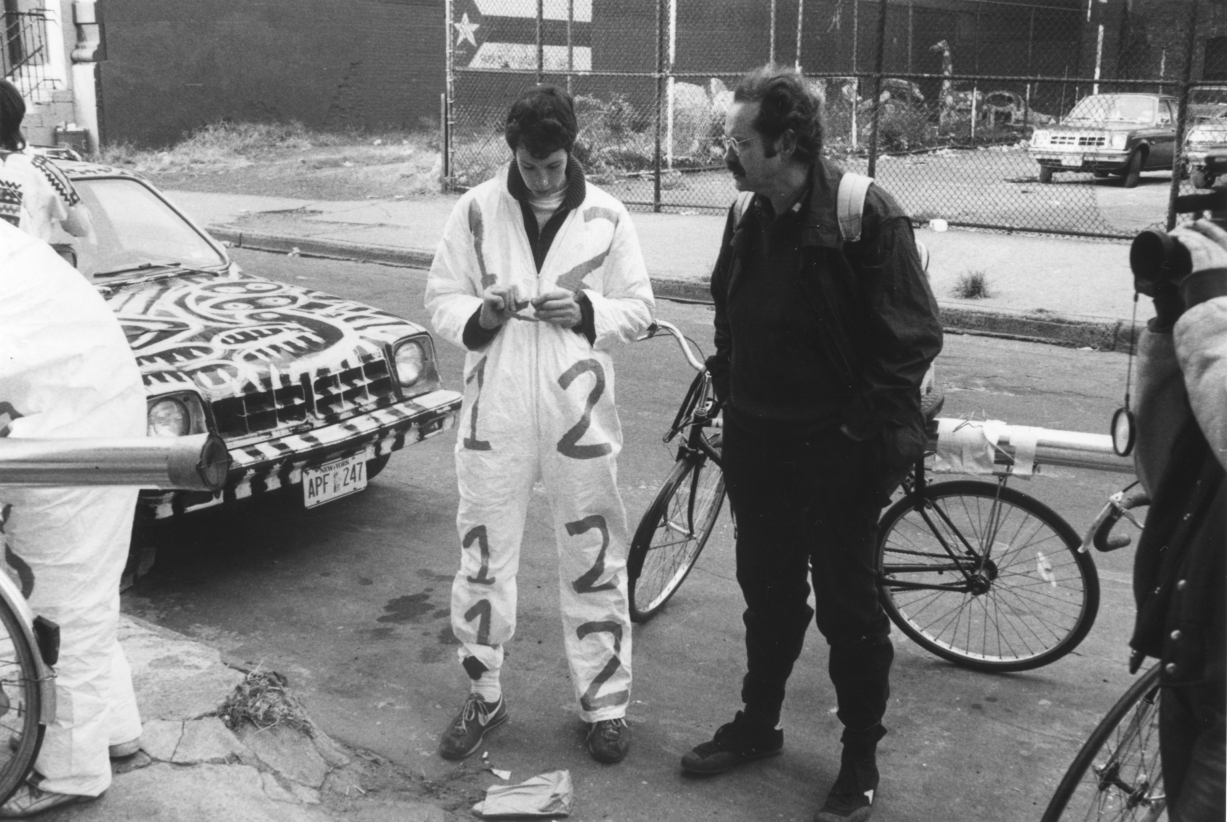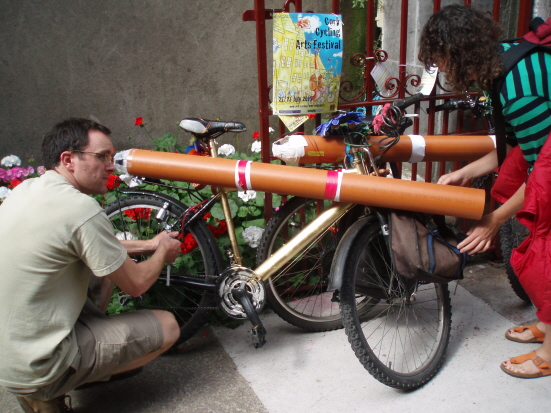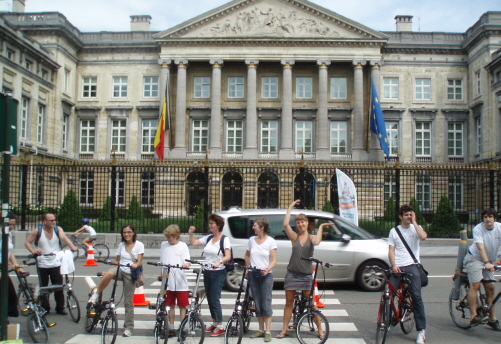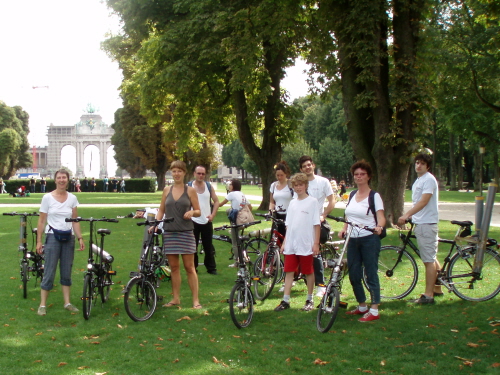The singing bicycles are the instruments of choice for any performance of Godfried-Willem Raes' second symphony, finished in 1976. The premiere of this symphony took place four years later, in 1980. The number of performers can range from a strict minimum of twelve, to about 144. The symphony up to now has been performed in many countries, over a hundred times in total. Important performances have taken place in New York, Ghent, Leuven, Eeklo, Zonnebeke, Den Bosch (Netherlands) , Bavikhove, Antwerp, Bracciano (Italy), Cork (Ireland), Brussels, Hasselt, Genk...
Singing Bicycles in Brussels, September 2010
Nederlandse versie:
Godfried-Willem Raes
"2e SYMFONIE"
Symfonie voor Zingende Fietsen
1980

Zingende Fietsen Symfonie: workshop, New York 1986

Zingende Fietsen Symfonie: workshop, Cork (Ierland), 2008)
De futuristen waren wellicht de eersten die de straat als podium prefereerden boven de concertzaal of het theater. Wellicht droomde ook jij er ooit ook zelf wel eens van deel te kunnen nemen aan de uitvoering van een grootse symfonie.
Welnu, de 2e Symfonie van Godfried-Willem Raes biedt je daartoe de gelegenheid. Zij is geschreven voor zingende fietsen en grijpt plaats op straat.
En, het is zelfs niet eens zo erg moeilijk, kijk maar: Je komt met je fiets tot bij ons en samen toveren we je fiets om tot een schitterend instrument. Ziezo, klaar, en nu kan je vertrekken. Jij en je collega's rijden in een lange rij over de straat. De laatste in de rij haalt iedereen in ... Zowel jijzelf als je publiek langs de weg zal de "Zingende Fietsen" Symfonie, die je zo tot klinken brengt, wonderlijk opwindend vinden.
Deze "Zingende Fietsen" Symfonie is een openlucht- gebeuren voor ten minste 12 fietsers met hun eigen fiets. Een workshop van hooguit 2 uur volstaat om de fiets te prepareren:
- Iedere fiets die geen dynamo heeft, wordt eerst voorzien van een dynamo waarmee elektriciteit wordt opgewekt. Een fietsdynamo wekt zogeheten wisselstroom op, d.w.z. een stroom die alsmaar op en afgaat in het draaitempo van de rotor. Gezien die snelheid afhangt van die van de fiets, zal ook de frekwentie van de opgewekte stroom afhankelijk zijn van de snelheid van de fiets.
- Deze dynamo wordt dan verbonden met een naar impedantie daarbij aangepaste luidspreker (16-25 Ohm). Dit is nodig om een optimale vermogensaanpassing tussen stroombron (de dynamo) en belasting (hier de luidspreker met buis) te verkrijgen. De spanning wordt eventueel binnen de perken gehouden door twee antiparallel geschakelde zenerdiodes. Het gemiddelde opgewekte vermogen van een een dynamo beloopt ongeveer 3 Watt, maar wanneer we echt hard gaan doortrappen kan makkelijk meer dan het driedubbele vermogen worden geleverd.
- Deze speciale luidspreker wordt dan gemonteerd op het open uiteinde van een PVC of metalen buis die naar diameter bij de luidspreker aansluit (5 tot 16 cm). Elke fiets krijgt nu een buis van verschillende lengte toebedeeld. De lengte van de buis bepaalt de toonhoogte van de laagste resonantiefrekwentie. De onderlinge lengteverhoudingen van de resonantiebuizen zijn voor de Symfonie voor Zingende fietsen, zo berekend dat een 'toonladder' in een systeem met ongetemperde intervallen (just intonation), gesteund dus op zuivere boventoonreeksen, ontstaat. Elke fiets heeft dus een eigen grondtoon en kan daarboven -als hij maar snel genoeg rijdt- een tot twee boventonen opwekken.
- Wanneer je met een wisselende snelheid rijdt,-versnellen en vertragen dus- bekom je glissandi . Wanneer in een glissando de eigen specifieke resonantiefrekwentie wordt bereikt, wordt de geluidssterkte plotseling veel luider en de overeenkomstige noot wordt sterk geaksentueerd. De partituur van de "Symfonie voor Zingende Fietsen" schrijft dan ook voor dat in principe alle fietsen in een aaneengesloten rij aan een matige en min of meer konstante snelheid vooruitrijden , waarbij de fietser die zich op dat moment helemaal achteraan bevindt , de hele rij snel moet voorbijsteken tot hij de kop van de rij heeft bereikt , waarop hij weer vertraagt tot de snelheid van de globale groep.
- Wanneer je nu echter op verschillende wegdekken fietst verkrijg je ook telkens wisselende klankeffekten en klankkleuren. Kasseien of zgn.kinderkopjes veroorzaken tremolos , smalle straten zorgen voor de nodige echo of nagalm...
- Iedere fietser draagt een witte overall waarop heel groot getallen zijn aangebracht die de verhouding weergeven van de lengte van de op de betreffende fiets gemonteerde buis (en dus van zijn karakteristieke toonhoogte) tot die van de buis met de grondtoon. Deze laatste is dan ook de langste buis. Alle verhoudingen tussen de buislengtes, en dus ook alle verhoudingen tussen de verschillende muzikale intervallen, zijn begrepen tussen 1/1 ( grondtoon) en 1/2 (oktaaf). Individuele en telkens verschillende noten treden alleen muzikaal op de voorgrond , telkens wanneer een of meer fietsers doorheen zijn eigen specifieke 'resonantiesnelheid' , of een veelvoud daarvan, gaat.
Organisatoren:
De Zingende Fietsen Symfonie behoort tot het vast repertoire van het Logos Ensemble. Het kan heel eenvoudig voor elke organisatie worden gebracht tegen een nominale uitkoopsom. Een kleine ploeg medewerkers van Logos komt bij jullie met alle benodigdheden en werktuigen voor de montage uitgezonderd de fietsen en hun berijders. De organisator staat zelf in voor het aanvragen van de nodige vergunningen bij de lokale politie. Dit is nodig omdat een goede uitvoering van het stuk kolonne-rijden noodzakelijk maakt.
English version:
Godfried-Willem Raes
Symphony for Singing Bicycles
1980


Singing Bicycles in Brussels, 2011
Have you ever dreamt of playing in a symphony? Have you heard of the early 20th-century Futurists who preferred to make art in the street than on canvas or in the theatre?
Maybe Godfried-Willem Raes' '2nd Symphony' could be your chance. And it isn't even very difficult: all you need to join the symphony is an ordinary bicycle. We will begin with a workshop where we carefully convert your bicycle into an exciting instrument. Then you and your colleagues cycle off in a long line at a regular pace. The last cyclist in line overtakes the whole group, joins the group at the front, and then the person who is now at the back overtakes the group in turn. The result is a fantastic pedalling, buzzing, howling Singing Bicycle Symphony that will delight you and your audience.
The 'Symphony for Singing Bicycles' is an open-air event scored for a minimum of twelve cyclists with their own bicycles. A workshop of two hours is enough to prepare the instruments for the performance:
- each bike receives a dynamo - if it doesn't already have one - to generate its own electricity (6 Volt / 3 Watts);
- a impedance-matched loudspeaker (16 to 50 Ohms) is connected to the dynamo. The power rating of the speaker should be at least 3 Watts, corresponding to the average power delivered by the generators.
- each loudspeaker gets a carefully calculated length of tube in order to obtain a specific musical scale;
- by cycling at different velocities, (the last cyclist continuously overtakes the whole group), glissandi are produced. At very specific velocities, resonance will occur in the tubes.
- by cycling over different surfaces, timbre variation and frequency modulation are obtained. Cobblestones provoke tremolo's, narrow streets reverberate and echo the sounds.
- every cyclist wears a white overall labelled - in large numbers - with the resonant frequency and the interval ratio (between 1/1 and 1/2) of his or her individual instrument.
Organisers:
The Singing Bicycle Symphony is part of the Logos Ensemble's permanent repertoire. It is very easy - and inexpensive - to set up. A small team of Logos technicians will come to your location with all the necessary tools to assemble the instruments and get the symphony going. You just need at least 12 volunteers and bicycles, and to get any permission required from your local police to ride the bicycles in convoy. For cities a long way from Belgium: the project may be cheaper to run if you can provide some or all of the materials required to make the instruments such as plastic drainpipes.
Version for the Peoples Republic of China :
"Symphony for Singing Bicycles": Chinese Version
To transform China's most popular means of transportation, the bicycle, into a musical instrument, is the starting point for a performance of the "Symphony for Singing Bicycles". The bicycle lies within reach of the greater part of the Chinese urban population. To transform this means of transportation into a musical instrument which can be used to perform a 'symphony', offers an instrument of music to all bicycle owners - as we said before, a great number of inhabitants of the People's Republic.
This metamorphosis is possible with simple means (a dynamo, simple electronics, a loudspeaker and a resonator). The bicycle owners prepare their own bicycles according to our indications and with the materials we provide. They operate the metamorphosis themselves, and all the time the bicycles' original function is kept.
The silent nature of the bicycle is transformed in a playful, musical way, and will now manifest itself sonorously in the midst of the city traffic.
Each bicycle has a tuned fundamental and a series of harmonics, which depend on the velocity of the cyclist. A 'Singing Bicycle' in motion produces automatically different timbres. A bumpy road will provoke tremoloes and narrow streets and alleys will provide a whole gamut of reverberations and resonances.
Once the 'instrument' is prepared the cyclists study the performance-rules. For the performance of the 'Symphony for Singing Bicycles' we would welcome a participation of about a hundred bikers per city. A queue of a hundred bikers is formed. 10 groups of about 12 bikers (in one row). The groups move at constant speed, while the last biker in each row speeds up and rides past the other bikers to the head of his group. Once there he slows down to the speed of the group, while the last biker in the row now does the same and rides past the others up to the head, and so on.
This way the group produces a constantly changing cluster, above which a single higher pitch rises (each time a different one).
The route to be followed is determined beforehand according to the construction lines of Velasquez' 'Las Meninas', it has to be within the limits of the most populated urban areas, thus making it possible for the largest number of people to witness the 'Symphony for Singing Bicycles'.
The Symphony should take place in three different cities, to symbolize the meeting of three cultures: Diego de Silva y Velasquez' 17th century Spain, contemporary China and the 20th century west.
Performance history:
- 1980: European premiere of the 'Symphony for Singing Bicycles'
- 1980-1983: performances in many European Cities
- 1983: ISCM World Music Days performance - Ghent
- 1983-1985: performances all over Europe
- 1985: The project was forbidden in the Kingdom of Brussels…
- 1985-sept: ITALIAN TV (R.A.I.) telecast from Trevignano ROME
- 1986: American premiere: New York City, Fusion Arts, 31.10.86 & 01.11.86: A complete set of instruments was sold to Charles Morrow Associates, NY.
- 1995: Ghent, City Parade on 15.07.1995.
- 1997: Den Bosch,Parade, Netherlands, Boulevard of Broken Dreams & November Music Festival 09.08.97-17.08.1997
- 1998: Antwerp, Schouwburg - Villanella, 11.04.1998-19.04.1998. Uitvoerders: Logos Ensemble- Guy De Bievre & Luk Vaes
- 1998: Antwerp, K.Albertpark, -Fietsersbond, 17.05.1998 12u-17u. Uitvoerders: Logos Ensemble- Leonaar Degraeve & Adriaan Denorme
- 2001: Bavikhove, 1 juli optocht. Uitvoerders: Logos Ensemble: Leonaar Degrave, Kurd Vandevelde, Moniek Darge, Ben Deceuninck, Godfried-Willem Raes
- 2008: Cork, Ireland, 26th July. Logos ensemble: Moniek Darge, Kati Couck, supervised by Godfried-Willem Raes
- 2010: Brussels, 19th September, with 24 bicyles. Logos ensemble: Moniek Darge, Kati Couck, Helen White, Sebastian Bradt, supervised by Godfried-Willem Raes
- 2011: Brussels, 21st August, Cyclovia. Logos ensemble: Moniek Darge, Kati Couck, Sebastian Bradt, supervised by Godfried-Willem Raes
- 2011: Brussels, 11 September, Cyclovia. Logos ensemble: Moniek Darge, Kati Couck, Kristof Lauwers, Helen White, supervised by Godfried-Willem Raes
- 2014: Hasselt and Genk, 5 oktober, Musica. Logos ensemble: Moniek Darge, Yvan Vander Sanden, Lara Vanwynsberghe, Katie Couck, Mattias Parent supervised by Godfried-Willem Raes. In this version two groups were formed, each composed of 15 bicycles.
LIST OF TECHNICAL REQUIREMENTS:
A minimum of 12 bicycles (let the number be X) with an electricity generator delivering 6 Volts at 3 Watts power output, as used for bicycle light installations / X cyclist performers
X loudspeakers with characteristics as follows:
- Impedance : 15 Ohms minimum - 50 Ohms maximum. The types we used for the original version of the singing bicycles were Philips, AD4472/X25 (4.5 Watt, 80-15000 Hz, resonant frequency at 170Hz, 25 Ohms). The AD4472/X15 (same characteristics, but 15 Ohms impedance) was also used. Both these types have a diameter of 105mm. These type are no longer produced and have become obsolete. For replacements or newer versions the Visaton K50WP can also be used. This type is rated at 3 Watt, 180-17000 Hz, but has a diameter of only 50 mm. The advantage is that it is weatherproof, but not quite as powerful in the low frequency range. Much more expensive but very good in sound, is the use of Padu100 drivers (16 Ohms, 100 Watts), but these are motor drivers and have to be used with conical pipes.
- Power rating: 3 Watts minimum - 25 Watts maximum. (Higher power ratings are o.k., but do not lead to improvements of the project)
- Diameter : 105mm ( equals 4.133858264" in antique inches ), to match the original 25 Ohm speakers. For the Visaton types (50 Ohms), 50mm pipe is a good match.
-X plastic tubes (sanitary P.V.C., light quality) cut to different lengths as follows :
- Sizes given in antique inches:
- 64.4" 58.9" 58.4" 57.8" 57.0" 56.2" 55.0" 53.4" 52.5" 51.3" 49.8" 48.0" 46.5" 45.6" 44.7" 42.5" 40.5" 39.7" 38.1" 37.0" 36.3" 35.2" 34.6" 31.6";
- Metric lengths given in internationally standardized centimetres:
- 182 161 159,5 158 156 153,5 150 146
- 143 140 135,5 130,5 126,5 124 121,5 115,5
- 110 108 103,5 100,5 98,5 95,5 93,5 85,5
- These lengths were calculated to form a scale of just intonation for 24 bicycles/tubes/players.
- The diameter of the plastic tube (drainpipe) used should be 10 cm (ca.4"). They have to match the diameter of the loudspeakers.
-Ordinary thin flexible multicore insulated electrical wire;
-Soldering Iron and solder, cutting pliers, flatnose pliers, stripping pliers, a pair of scissors, screwdrivers;
-1 large roll of very strong heavy duty sticky-tape, (gaffer tape) width ca. 2" (prehistoric inches...)
-a toolkit for standard bicycle repair and maintenance.
A complete set of tuned pipes, loudspeakers and dynamos is available from the Logos Foundation. Please enquire for rental conditions.
FICHE TECHNIQUE:
- un minimum de 12 bicyclettes avec une dynamo de 6 Volt,3 Watt et un point de contact pour la masse
- le meme nombre de haut-parleurs de minimum 15 Ohm ou maximum 25 Ohm, et de minimum 3 Watt ou maximum 25 Watt
- le meme nombre de tuyaux en PVC (sanitaire) du meme diametre que les haut-parleurs et de longueurs differentes :
Longueurs (en cm) pour 24 bicyclettes :
182 161 159,5 158 156 153,5 150 146 ,143 140 135,5 130,5 126,5 124 121,5 115,5 110 108 103,5 100,5 98,5 95,5 93,5 85,5
Longueurs (en cm) pour 12 bicyclettes:
182 159,5 156 150 143 135,5 126,5 121,5 110 103,5 98,5 93,5
- fil electrique (multibrin, souple)
- fer a souder et soudure
- pince a couper et pince a denuder
- ruban adhesif solide d'une largeur d'environ 5 cm
- des paires de ciseaux et tournevis
- une serie d'outils de montage pour bicyclettes
Relevant calculations for the Singing Bicycle Project:
Traditional bicycle dynamos or generators have a permanent magnet rotor with 2, 4, 6, 8 or even 16 poles. There generally is a relation between the number of poles and the price. It's easy to tell how many poles a given dynamo has, by turning the dynamo top wheel by hand and counting the magnetic bumps it lets you feel for a full revolution. The output is an AC voltage (nominally specified as 6V / 3W) whereby the frequency is a function of the speed of propagation of the bicycle, the radius of the dynamo wheel pushing against the rim of the wheel and the number of poles (p). The diameter of common dynamo wheels varies between 20 and 30 mm. Thus the relation between speed (v) and generated frequency is: f = v * p / 2¶r, when r = the radius of the dynamo wheel. Worked out for a speed of 15km/h and r = 12.5mm (25mm wheel) , using an 8 pole dynamo this gives a frequency of 424Hz. Doubling the speed will sound the octave.
Often one encounters bicycles equiped with axle generators built into the wheel. Although these work along the same principle, they cannot be used for the Singing Bicycle project since their speed of rotation is way too low. Note that this type of generator makes only a single revolution for every rotation of the entire bicycle wheel. The formula for the frequency than becomes: f = v * p / 2¶R, where R is the radius of the bicycle wheel. Worked out for a wheel diameter of 70cm, 8-poles and a speed of 15km/h (=4.16 m/s) this yields a frequency of only 15Hz...
Taking the common 6V / 3W generator as a point of reference, we can calculate its internal resistance as Ri = U^2 / P, or in values: Ri = 36/3= 12 Ohm. For an optimum power coupling between generator and loudspeaker this means that the latter ought to have an impedance of no less than this value. Hence we found 16 Ohms a suitable value in practice. Note that the actual voltage obtainable from a bicycle dynamo can run up to ca. 18V. Even if the current stays at ca. 0.5 A, the power rises to 9W. Loudspeaker power handling capacity is most often expressed as 'music' power, whilst here we have an (almost) pure sinusoidal signal. Hence to stay on the safe side, loudspeakers with a power rating of 9W * 2 * SQR(2) = 25W should be used. These specifications will lead you right into the selection of horn-driver speakers, where such impedances and power ratings are quite common. When such compression drivers are used, they must be coupled to conical tubes calculated to resonate on the frequencies as given in the instructions above. Alternative tuning systems are possible and thus in 2014 me made a version with the tubes tuned to the duodecime divided into 24 equal tempered intervals. Would you believe this to be the equation for calculating singing bicycles? f = 317.6497 -.4827873 x + 2.720424E-04 x^2 + 2.693052E-08 x^3 -5.110973E-11 x^4 -1.656992E-14 x^5 + 1.248304E-17 x^6. This sixth degree equation applies to PVC drain pipe 50 mm in diameter, coupled to Visaton K50WP speakers. f is the fundamental resonant frequency and x the tube length expressed in mm.
Godfried-Willem Raes
P.S.: Voor uitvoeringen van dit stuk moeten noch mogen auteursrechten worden betaald. Elke poging tot inning van auteursrechten naar aanleiding van publieke uitvoeringen van dit stuk kan gerechterlijk als poging tot afpersing worden vervolgd.
P.S.:This composition by Godfried-Willem Raes is herewith placed into the public domain. There are no royalties to be paid. The author should be mentioned at any performance.
